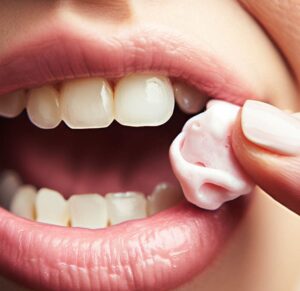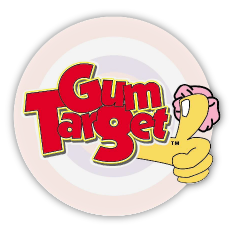Chewing gum may be a favourite pastime for many, but the residue they leave behind, especially when disposed of irresponsibly, is a nightmare for homeowners and municipalities alike. Chewing gum littering poses both environmental and aesthetic problems, making their removal paramount.
Understanding The Problem

Chewing gum, a common delight for many of us, becomes a major headache when it finds its way onto various surfaces, resulting in unsightly stains and residue. The main reason behind this problem lies in the composition of the chewing gum itself.
The primary constituents of chewing gum are a gum base, along with sweeteners, and flavourings. While the sweeteners and flavourings provide the taste we enjoy, it is the gum base that gives chewing gum its characteristic resilience and stickiness. The gum base is typically made up of resins, waxes, and fats, creating a substance that is not only highly adhesive but also resistant to many forms of cleaning. This composition effectively means that the chewing gum can adhere strongly to a multitude of surfaces, making it incredibly hard to remove.
Sidewalks are one of the most common victims of gum littering. The gum gets bonded to the concrete, making it a challenging task to clean. Not only does this tarnish the aesthetic appeal of these areas, but it can also pose a hazard if someone slips or trips on the discarded gum.
Indoor furniture, such as tables and chairs, particularly in public areas, are also often affected. Unfortunately, some people stick their used gum under tables or onto chairs instead of properly disposing of it. This results not only in a unsanitary and uncomfortable discovery for the next user, but it also makes cleaning a more time consuming and challenging task for the responsible staff.
Carpets and shoes are yet another commonly affected area. Stepping on gum can not only ruin the shoes’ aesthetics but may also damage the material over time. Similarly, extracting gum from carpet fibers can be extremely difficult and may require professional cleaning.
The widespread nature of this problem, coupled with the tenacity of chewing gum, necessitates the need for effective and efficient gum removal methods. These methods must be able to break down the sticky properties of the gum base and remove it from various surfaces without causing any additional damage. Thus, understanding the problem at its root is the first step towards developing or employing suitable chewing gum removal strategies.
Common Gum Removal Methods
While dealing with stuck chewing gum, people often resort to certain common methods that include the use of ice, heat, or even plain physical scraping. These methods showcase varying levels of effectiveness and may even have their share of drawbacks.
The use of ice cubes is one widely known home-remedy method for gum removal. The idea behind this is that the low temperature of the ice will harden the gum, making it less sticky and easier to remove. This method can be somewhat effective for freshly stuck gum and on certain surfaces like clothes or hair. However, it has limited effectiveness on porous or textured surfaces like pavements and carpets. Also, the process of applying ice and scraping off the gum can be time-consuming and cumbersome.
The method of applying heat is from the opposite spectrum. The theory is that by gently heating the gum, it is possible to soften it to a point where it can be easily wiped away. A common way to apply this method at home might involve using a hairdryer to deliver low and controlled heat to the gum. While this can partially melt the gum, making it easier to remove from smooth or solid surfaces, it can also spread the gum further into porous or fibrous surfaces, thus complicating the issue.
Scraping the gum off is another common method, often used in conjunction with the above-mentioned techniques. Once the gum is hardened by ice or softened by heat, people use a spatula, knife, or similar tools to physically remove the gum. Yet, this method carries the risk of causing damage to the surface being cleaned, especially if it is delicate or soft. It also tends not to remove all of the gum, leaving unsightly residues behind.
These methods can often require a great deal of time and effort, especially for stubborn, old gum stains. Depending on the surface and the age of the gum, significant elbow grease may be required, making these methods physically demanding and often frustrating.
While ice, heat, and scraping techniques provide common and widely accessible tools in the fight against gum litter, they frequently prove inadequate in fully addressing the problem. They can be time-consuming, demanding, and carry the risk of damaging the surface to which the gum is attached. These situations call for more effective gum removal techniques that can handle the tenacity of chewing gum while being gentle on various surfaces.
Steam Cleaning
Steam cleaning has emerged as a particularly efficient method for tackling chewing gum removal. This approach primarily uses the power of high-temperature steam to overcome the sticky resilience of chewing gum.
The steam cleaner works by heating water to an extremely high temperature to generate steam. This steam is then directed at the gum-stuck surface. The intense heat effectively melts the gum, causing it to lose its adhesive properties. The gum then becomes soft and pliable, making it much easier to lift and remove, often without leaving any residue behind.
Ыteam cleaning is not only useful for removing the gum itself but can also help eradicate any stains or discoloration left behind by the gum. The steam’s heat helps to break down the compounds causing the discoloration, restoring the original appearance of the surface.
Added to its efficiency, steam cleaning is also a relatively eco-friendly method. It uses water as the main cleaning agent, reducing the need for potentially harmful chemical cleaning agents.
Вspite the impressive performance of steam cleaning in gum removal, there are some practical limitations to its widespread use. The most significant among these is the need for specific equipment. A proper steam cleaner, capable of generating a high-temperature steam, is a necessity for this method. This specialized equipment often comes with a hefty price tag, which may make this method not cost-effective for everyday use.
Using a steam cleaner requires a certain level of expertise to ensure both safety and effectiveness. The steam generated in this method can cause burns if not handled properly. Also, the cleaning process needs to be controlled to prevent potential damage to sensitive surfaces due to the high heat.
While steam cleaning has proved to be a highly effective method for removing chewing gum from various surfaces, its application is restricted due to the requirement of specialized equipment and the associated costs. It may serve as an excellent solution for professional cleaning services or in areas frequently beleaguered by discarded gum. Nonetheless, it may not be the most practical solution for everyone or for every instance of gum disposal.
Innovative Gum Removal Techniques

The persistent challenge of chewing gum removal has fueled the development of innovative methods to tackle this sticky problem. These novel techniques, while promising, are still in various stages of development and commercial implementation.
Gum-removing solvents are one such innovation. These are specialized chemical substances designed to break down the gum base’s adhesive properties effectively. When applied to the gum, these solvents swiftly work to dissolve the gum, making it easy to wipe away. This technique drastically reduces the effort and time needed to remove gum from various surfaces and is particularly useful for surfaces where traditional methods tend not to work well. However, these solvents should be handled with care, and their potential effects on different materials need to be taken into account. Also, their eco-friendliness and impact on human health would need to be assessed further before widespread use.
Another fascinating advancement is the use of bio-remediation or harnessing the power of naturally occurring bacteria to “eat” the gum. Various emerging startups are studying different strains of bacteria that feed on the compounds present in the chewing gum. When these bacteria are applied to a gum-laden surface, they consume the gum base, effectively disintegrating it and thus facilitating easy removal. As a bonus, this process is completely eco-friendly and makes use of a renewable resource—bacteria. However, this approach is very much in the experimental stage, and a lot more research and testing would be required to mature this technique into a commercially viable solution.
These new techniques open exciting possibilities for chewing gum removal, promising more potent, efficient, and eco-friendly solutions. However, given their relatively recent development, they may not be immediately available for everyday use. Investment in research, development, and commercial viability studies would be crucial to bring these techniques from the laboratory into the market and harness their potential in combating chewing gum disposal issues effectively.
Preventive Measures
A holistic approach to handling the problem of chewing gum litter must incorporate preventive measures, alongside removal techniques. These preventive strategies aim to reduce gum waste instances at their source by cultivating awareness and promoting responsible practices.
Education plays a crucial role in prevention. Comprehensive education campaigns help raise awareness about the environmental impact of improper gum disposal. They also promote responsible gum disposal habits, such as throwing gum in trash receptacles instead of discarding them on surfaces. Implementing these campaigns in schools, community groups, or through public service announcements can impact a wide audience and bring about a significant change in behavior.
Providing specific, designated gum disposal bins is another proactive solution. These can be standalone units or can be incorporated as part of regular litter bins. Having these bins, especially in areas with high foot traffic or where gum chewing is prevalent, offers a convenient and noticeable option for users to discard their gum responsibly. Celebrities and public figures can even endorse these bins, further increasing their visibility and usage.
Imposing penalties or fines for littering gum is a more stringent preventive measure. By attaching a consequence to irresponsible disposal of gum, authorities can dissuade people from littering. Enforcement of such penalties, however, needs to be consistent and coupled with public awareness campaigns so people understand the reasoning for the rules.



